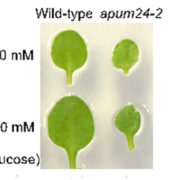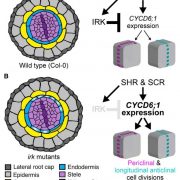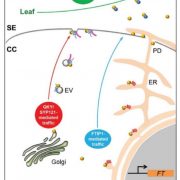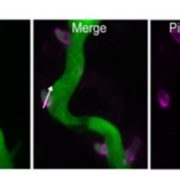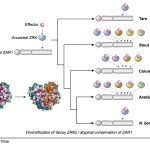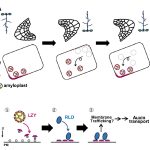Membrane lipid phosphoinositides signature the final step of plant cytokinesis
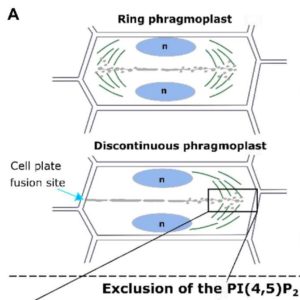 Phosphoinositides (membrane lipids with cytosolic inositol headgroups carrying phosphate residues at various positions) serve as road markings for membrane and membrane/cytoskeleton dynamics. Here, Lebeco et al. add further detail to the map. Previously the authors showed that the plant-specific enzyme phosphoinositide phosphatase SAC9 participates in the restriction of phosphatidylinositol 4,5-bisphosphate [PI(4,5)P2] at the plasma membrane during endocytosis. In this study, they demonstrate a novel role for PI(4,5)P2 in the final stage of cytokinesis, when the cell plate connects with the maternal membrane. As the cell plate is expanding towards the maternal membranes at the edge of the dividing cell, SAC9 protein is enriched at the leading edge and its substrate PI(4,5)P2 is depleted. When the phragmoplast attaches, SAC9 protein is dissipated. In loss-of-function sac9 mutants, PI(4,5)P2 is present at the leading edge of the phragmoplast and branching occurs from the phragmoplast. The authors propose that the presence of PI(4,5)P2 at the phragmoplast leading edge leads to to ectopic recruitment of the cytokinesis apparatus and formation of an additional cell plate insertion site. (Summary by Mary Williams @PlantTeaching) Sci. Adv. 10.1126/sciadv.adf7532
Phosphoinositides (membrane lipids with cytosolic inositol headgroups carrying phosphate residues at various positions) serve as road markings for membrane and membrane/cytoskeleton dynamics. Here, Lebeco et al. add further detail to the map. Previously the authors showed that the plant-specific enzyme phosphoinositide phosphatase SAC9 participates in the restriction of phosphatidylinositol 4,5-bisphosphate [PI(4,5)P2] at the plasma membrane during endocytosis. In this study, they demonstrate a novel role for PI(4,5)P2 in the final stage of cytokinesis, when the cell plate connects with the maternal membrane. As the cell plate is expanding towards the maternal membranes at the edge of the dividing cell, SAC9 protein is enriched at the leading edge and its substrate PI(4,5)P2 is depleted. When the phragmoplast attaches, SAC9 protein is dissipated. In loss-of-function sac9 mutants, PI(4,5)P2 is present at the leading edge of the phragmoplast and branching occurs from the phragmoplast. The authors propose that the presence of PI(4,5)P2 at the phragmoplast leading edge leads to to ectopic recruitment of the cytokinesis apparatus and formation of an additional cell plate insertion site. (Summary by Mary Williams @PlantTeaching) Sci. Adv. 10.1126/sciadv.adf7532



